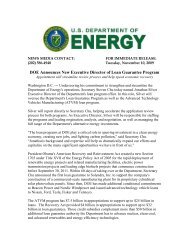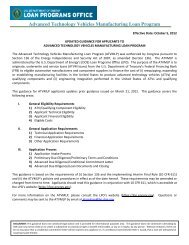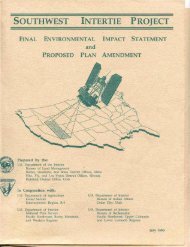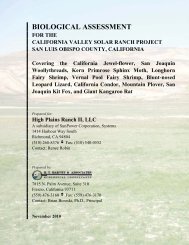Bureau of Land Management's Decision Record and Environmental
Bureau of Land Management's Decision Record and Environmental
Bureau of Land Management's Decision Record and Environmental
You also want an ePaper? Increase the reach of your titles
YUMPU automatically turns print PDFs into web optimized ePapers that Google loves.
Attachment E<br />
CONDITIONS OF APPROVAL FOR GEOTHERMAL UTILIZATION<br />
As surface disturbing activities occur, the BLM will require the operator to monitor the water<br />
temperature <strong>and</strong> outflow or water from local hot springs <strong>and</strong> existing wells as directed by the<br />
Assistant Field Manager. If the temperature <strong>and</strong> outflow from the spring or well were impacted<br />
to a degree determined by the Assistant Field Manager to be more than negligible, the BLM shall<br />
require the operator to take corrective actions. Failure <strong>of</strong> the operator to take the corrective<br />
measures as directed will result in BLM terminating the operation.<br />
Special Status Species<br />
The lease area may now or hereafter contain plants, animals, or their habitats determined to be<br />
threatened, endangered, or other special status species. The special status species list is reviewed<br />
<strong>and</strong>! or updated annually <strong>and</strong> as species are added, new mitigations/stipulations may add further<br />
restrictions. BLM may recommend modifications to exploration <strong>and</strong> development proposals to<br />
further its conservation <strong>and</strong> management objective to avoid BLM approved activity that will<br />
contribute to a need to list such a species or their habitat. BLM may require modifications to or<br />
disapprove proposed activity that is likely to result in jeopardy to the continued existence <strong>of</strong> a<br />
proposed or listed threatened or endangered species or result in the destruction or adverse<br />
modification <strong>of</strong> a designated or proposed critical habitat. BLM will not approve any ground-<br />
disturbing activity that may affect any such species or critical habitat until it completes its<br />
obligations under applicable requirements <strong>of</strong> the Endangered Species Act as amended, 16 U.S.C.<br />
§ 1531 et seq., including completion <strong>of</strong> any required procedure for conference or consultation.<br />
Exploratory endeavors on the public l<strong>and</strong>s will require a Special Status Species review, <strong>and</strong> may<br />
require a field survey for the presence <strong>of</strong> Special Status Species. Potential impacts to Special<br />
Status Species will be analyzed on a case-by-case basis. Mitigation measures shall be developed<br />
on an individual basis depending upon the results <strong>of</strong> the survey.<br />
Springs within ½ mile <strong>of</strong> exploration activities shall be inventoried by BLM approved <strong>and</strong><br />
supervised personnel for the presence <strong>of</strong> invertebrates. If a rare genus, such as Pyrgulopsis, is<br />
found, identification to species <strong>and</strong> monitoring <strong>of</strong> effects <strong>of</strong> the proposed action shall be required<br />
<strong>and</strong> site-specific mitigation may be developed by the BLM.<br />
Sage grouse: BLM will require operations to avoid active leks (strutting grounds) by 2 miles<br />
during strutting season (see Management Guidelines for Sage Grouse <strong>and</strong> Sagebrush Ecosystems<br />
in Nevada, October 2000). Approximate dates: March 1 -<br />
May<br />
15<br />
Operations would avoid nesting <strong>and</strong> brood rearing habitat (especially riparian habitat where<br />
broods concentrate beginning usually in June) by ½ mile during the time such areas are in use.<br />
Approximate dates: April I August 15<br />
Operations would avoid sage grouse wintering habitat by ½ mile, while occupied. Most known<br />
wintering grounds in the Shoshone-Eureka Resource Area occur at high elevations <strong>and</strong> are not<br />
likely to be affected. Avoidance dates will vary with severity <strong>of</strong> the winter.<br />
13







